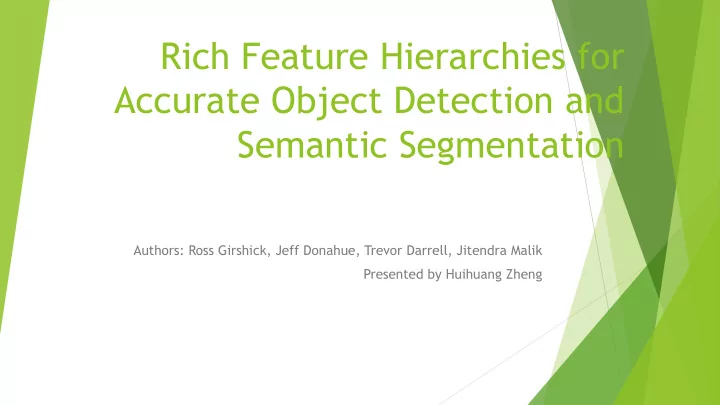

Rich Feature Hierarchies for Accurate Object Detection and Semantic Segmentation Authors: Ross Girshick, Jeff Donahue, Trevor Darrell, Jitendra Malik Presented by Huihuang Zheng
Problem: Object Detection Regionlets SegDPM (2013) Selective Search Regionlets DPM++, (2013)e DPM++, MKL, DPM++ MKL, Selective DPM, Search MKL DPM, HOG+BOW DPM Source: http://www.cs.berkeley.edu/~rbg/slides/rcnn-cvpr14-slides.pdf
Feature Learning with CNN Previous best-performance methods: plateaued, complex This paper: simple, scalable Two main contributions: Apply CNN to bottom-up region proposals to localize Fine-tune the CNN when lack of training data
Main Procedure
Step 1: Extract Region Proposals Region Proposals: many choices Selective Search [Uijlings et al.] (Used in this work) Objectness [Alexe et al.] CPMC [Carreira et al.] Category independent object proposals [Endres et al.]
Step 2: CNN Feature c. Forward propagation, extract “fc7” layer feature Krizhevsky’s AlexNet 16 for dilation
Step 3: Classify Regions Linear Classifier: SVM SVM here improves accuracy! (50.9% to 54.2%) CNN classifier doesn’t stress on precise location SVM will be trained with hard negatives while CNN was trained with random background Softmax
Step 4: Modify Regions A lot of scored regions Reject regions with intersection-over-union (IoU) overlap with a higher scoring selected region (learned threshold) Bounding box regression Get higher accuracy
Training: What if we lack of training data Solution: Use pre-trained CNN (the one trained with sufficient data) Fine-tune to specific task. Fine-tuning also increases accuracy. Details in paper: AlexNet [Krizhevisky et al.] Stochastic gradient descent (SGD) with learning rate of 0.001, (1/10 of initial) Replace 1000-way classification layer to 21-way Region with >= 0.5 IoU overlap with ground-truth box as positive, others as negative.
Experiment Result Source: http://www.cs.berkeley.edu/~rbg/slides/rcnn-cvpr14-slides.pdf
Source: http://www.cs.berkeley.edu/~rbg/slides/rcnn-cvpr14-slides.pdf
How does fine-tuning and bounding box influence result Left: without fine-tuning, middle: with fine-tuning, right: with fine-tuning and bounding box • Conclusion: Error type of R-CNN is more about location. Suggesting that CNN feature is more discriminative • Bounding box helps significantly in location problem. •
Detection Speed and Scalability Source: http://www.cs.berkeley.edu/~rbg/slides/rcnn-cvpr14-slides.pdf
Interesting visualization: what was learnt by CNN Visualizing method: Neurons with highest activation Receptive field
Visualization: some interesting images
Related Future Work Papers Fast R-CNN, by Ross Girshick R-CNN is slow, training is multi-stege, features from each object proposal Sharing computation by computing a convolutional feature map for entire input image Fast R-CNN Main idea: Compute a global feature map, computing region of interest in pooling layer, full-connected layer to give prediction and location. Faster R-CNN: Towards Real-Time Object Detection with Region Proposal Networks by Shaoqing Ren, Kaiming He, Ross Girshick, and Jian Sun Bottleneck of Fast R-CNN is region proposals Faster R-CNN computes proposals with a CNN (Region Proposal Networks (RPN))
Time Comparison Train Time (hours) on VOC07 Test Time (s/image) on VOC07 90 50 45 80 40 70 35 60 30 50 25 40 20 30 15 20 10 10 5 0 0 R-CNN R-CNN VGG R-CNN VGG Fast R-CNN Fast R-CNN Fast R-CNN R-CNN R-CNN VGG R-CNN VGG Fast R-CNN Fast R-CNN Fast R-CNN AlexNet deep AlexNet VGG VGG deep AlexNet deep AlexNet VGG VGG deep
Discussion & Questions 1. Is simple scale the best way to make region proposals capable for CNN input? 2. If we have a more precise CNN, will the object detection framework in this paper be better? 3. Why do we use SVM at top layer? 4. Is fc7 better for detection and fc6 better for localization and segmentation? Thank you!
Recommend
More recommend